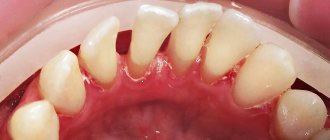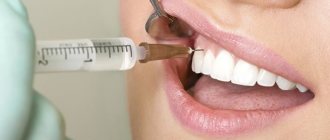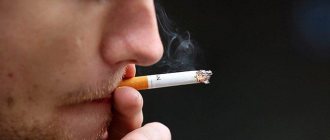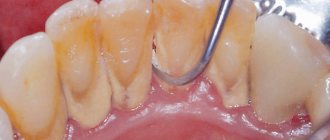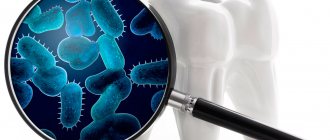Smoking and bad breath Dentists never cease to convince their patients that smoking not only harms the human body in general, but also primarily has a detrimental effect on the condition of the teeth and lungs. Regularly inhaling and exhaling toxic smoke, over time, bad breath appears, and this is the first news that the body is susceptible to toxicity.
Where does bad breath come from after quitting smoking?
Bad breath, or, in other words, halitosis, in the case of people who have given up smoking, appears due to dysbiosis of the oral cavity. After an abrupt cessation of the intake of nicotine, hydrocyanic acid and tars, a restructuring of all metabolic processes occurs, including changes in the functioning of the gastrointestinal tract, and the oral cavity, intestines and respiratory tract begin to be populated by beneficial bacteria, while harmful microflora die. This process lasts no more than a few weeks and, with the right lifestyle, goes away without a trace.
Considering that smoking and healthy teeth are not compatible, it is not difficult to understand that an unpleasant odor can also be an alarming signal that requires a visit to the dentist. By settling on the surface of the teeth, tobacco tar destroys the enamel, causing caries and periodontal disease, the manifestation of which, in fact, is halitosis.
An unpleasant odor is also emitted by sputum secreted from the lungs and bronchi, which will create discomfort until the respiratory tract is completely cleared. And finally, in those who quit smoking, bad breath is explained by increased consumption of sweets as an alternative to cigarettes, which causes active breakdown of protein in the oral cavity.
What to do if your child really smokes
Looking for signs of smoking, parents fear for the health of the student, but do not always imagine how to properly talk with him. The main rule of a difficult conversation is not to start with judgment. It is important to admit to yourself that teenage smoking is a pedagogical omission, which parents are also involved in.
Threats, reproaches, and unflattering expressions addressed to the child will only lead to him taking a defensive position and realizing that it is not worth being frank with his parents. It should be thought that the teenager started smoking because he did not understand that it was really harmful. And perhaps he did it secretly, so as not to upset anyone.
In an ordinary family, information about the dangers of smoking should be known to preschoolers. Whenever appropriate, parents can supplement it with new facts that their son or daughter can understand and accept due to their age. But if a teenager has already tried cigarettes, you need to think about how to have a conversation and help the child quit smoking.
You should not start a conversation immediately after discovering “evidence”. It is important to calm down, choose the correct wording and think about what made the child take up cigarettes. Parents smoking? A great way to quit yourself. Difficulties in family or school, desire to impress? Finding the cause will allow you to find a resource for breaking the habit.
- If a child admits to smoking, it is worth voicing your position on this matter and expressing regret. It is worth mentioning that a teenager can count on the help and love of his parents.
- Ask about smoking. It is necessary to find out how long ago the child tried cigarettes, how often and why he smokes. Information about how his friends feel about this habit will also be important. If the child has questions, they must be answered.
- It is worth emphasizing that starting to smoke early, children risk remaining captive to a bad habit for the rest of their lives. This unexpected statement helps break the myth “I’ll just try a little and I can quit at any time.”
- No blackmail, threats or manipulation. If the Internet is available, the child will check for himself whether the “horror stories” about smoking are true. It must be said that smoking in itself does not provide any benefits. Perhaps the teenager is not yet able to assess the risk of disease. The financial side of the issue may sober him up.
- If a child starts smoking “out of boredom”, out of a desire to appear more mature and significant, you should consider joining a sports club, offering to study at a language school or modeling studio.
- At some point, parents may realize that they cannot cope with the situation and cannot establish contact with the teenager. It is necessary to seek the help of a specialist. In such cases, adolescent narcologists recommend starting with a visit to a psychologist or psychotherapist.
Smoking in childhood worsens the quality of life and most likely leads to addiction. Love, sincere interest in your child, and timely information about the dangers of the habit will prevent its occurrence or help the teenager cope with the craving for cigarettes.
Possible consequences
Bad breath is not only an annoying phenomenon, but also an alarming symptom of a number of serious diseases. To rule out their presence, you should definitely consult a doctor, take a comprehensive blood test and undergo a full examination by specialized specialists.
If you ignore halitosis, artificially masking its presence with menthol aerosol and other tricks, it is easy not to notice how an ailment that could be defeated in no time or even prevented will go into a chronic stage and become a companion for life. In addition, aesthetic dentistry is not cheap at all, and purchasing implants instead of your own, healthy teeth is an extremely expensive and dubious pleasure.
Reasons for appearance
Friends and family often don't know how to report bad breath without offending someone they care about. Such delicacy keeps many who suffer from such a serious problem as chronic bad breath in the dark. The main causes of bad breath:
- unhealthy food;
- smoking;
- alcohol;
- features of the microflora of the oral cavity;
- diseases of the oral cavity and internal organs;
- improper oral care;
- taking certain medications.
A common reason for the smell is eating food with a strong smell (garlic, raw onions, etc.). After digestion of food products, those components that are not absorbed by our body are excreted in stool, urine and exhaled air. Some of these components released during exhalation have a very unpleasant odor.
Most smokers also suffer from an unpleasant specific odor in the mouth. Nicotine, tar and other foul-smelling substances contained in tobacco smoke accumulate on the teeth and soft tissues of the smoker's mouth - gums, cheek tissue, tongue. Smoking dehydrates the tissues in your mouth. This weakens the moisturizing and disinfecting effect of saliva, which washes away bacteria and their metabolic products. People who smoke are more likely to experience problems associated with periodontal disease (gum disease). Periodontal diseases also occur due to bacterial activity. Gum disease and its relationship with oral odor and dry mouth are discussed in more detail below.
Another reason that causes an unpleasant odor is stress. The sympathetic nervous system is activated during times of stress and saliva production is significantly reduced. And it is necessary for moistening the oral cavity, as well as for moistening food.
And anything that dries out the mouth contributes to the appearance of bad odor. The process is explained by the fact that the gases emitted by bacteria are usually bound by saliva and swallowed. But when dry, the gases evaporate. But this can be easily dealt with with water, liquid and chewing gum.
One of the culprits of the unpleasant odor may be an excess of protein in the diet and a lack of carbohydrates. In this case, the fat is broken down by the liver, which leads to the release of ketones, which emit an unpleasant odor.
Alcohol increases the dryness of the oral mucosa and promotes the active proliferation of microorganisms. Therefore, drinking alcoholic beverages may increase the problem of bad breath.
In most cases, the occurrence of bad breath is associated with the condition of the oral cavity. Namely: an unpleasant odor is usually caused by bacteria living in it. The waste products of some types of bacteria are sulfur compounds, and they are the main cause of the unpleasant odor. Every person has this smell in their breath to one degree or another. The human sense of smell does not detect it in small quantities. Only with a significant increase in the concentration of this unpleasant odor does the breath become stale. The main amount of foul-smelling substances that form bad breath is released by bacteria after consuming proteins. In the mouth there is always “natural” protein food for them, for example, dead skin cells or numerous protein components contained in saliva, as well as food debris. If you use a toothbrush and floss (thread) irregularly, favorable conditions are created in your mouth for the growth and reproduction of bacteria. In addition, with poor oral hygiene and the presence of carious teeth, food debris that accumulates in the interdental spaces and carious cavities undergo rotting, which also contributes to the unpleasant odor. Even in the absence of teeth, dentures can cause odor in the mouth (due to the accumulation of food debris under the dentures). However, sometimes even the most thorough brushing and flossing of your teeth won't completely get rid of the odor. The problem is that the odor-producing microflora often lines the hollows and cracks of the tongue and can be covered with a protective layer of mucus. Therefore, it is necessary to add tongue cleaning to the teeth cleaning procedure; usually, special scrapers are used for this purpose or, in the absence of the latter, an ordinary spoon.
The most common cause of bad breath is periodontal disease.
One of the factors contributing to increased formation of bacterial plaque is dry mouth (xerostomia). With dry mouth, the protective effect of saliva is not expressed. Neutralization of bacteria slows down, and conditions for their growth are created. One of the most striking examples is bad breath in the morning after sleep. During sleep, salivation decreases and bacteria begin to multiply intensively, and their waste products cause an unpleasant odor. Dry mouth can get worse with age. Over time, our salivary glands stop working with the same efficiency, and the composition of saliva also changes. This leads to the fact that the cleansing properties of saliva are weakened.
How to get rid of unpleasant odor after smoking
There is only one way to get rid of an unpleasant odor after quitting smoking - an integrated approach, including cleansing the lungs and bronchi, dental treatment and normalizing the functioning of the stomach.
So, first of all, it is necessary to do inhalations with disinfectant compounds that help remove from the body the layer of tar and other products of tobacco combustion that have settled on the mucous membranes.
Secondly, in the first time after quitting cigarettes, it is important to observe oral hygiene more carefully, not forgetting to brush your teeth with a good paste with a high calcium content after every meal and even drink.
Thirdly, you should be more selective in matters of nutrition, giving preference to vegetables and fruits, and categorically refusing hot, spicy foods and saturated sugars. And, to complete the set of measures, those who quit smoking need to gargle and gargle with herbal solutions.
Conventional rinses will not work here, since in this case it is important not just to deodorize the mouth, but to effectively disinfect it. Dentists recommend that anyone who, having given up smoking, fears for their teeth and suffers from bad breath, during the first years after quitting tobacco, should visit a doctor for preventive purposes once every two to three months, instead of the usual twice a year.
Changes in appearance and behavior
Against the background of regular or periodic smoking, the child’s behavior also changes.
This is how parents discover a lighter, tobacco crumbs, electronic or regular cigarettes in a teenager’s personal belongings. The child may say that the objects belong to a “friend,” but more often this will be an attempt to shield himself.
Smoking tobacco leads to the appearance of a characteristic odor from the hair and belongings of a teenager. Children try to disguise it with deodorant and perfume. If parents do not smoke themselves, they will be able to distinguish the smell of tobacco from perfume.
The desire to “go out, walk down the street”, “meet a friend” more often than usual. As a rule, walks last a short time. If the parents refuse (for example, the intention to go out to “breathe” at a late time), the child becomes irritated, but cannot explain his behavior.
After returning from the street, the teenager tries to thoroughly wash his hands, brush his teeth, and only then approaches his mother or father. If such habits are not typical for a child, you should think about it - perhaps he has something to hide.
When smoking at home, a teenager begins to ventilate his room more often, leaving the window open even in the cold season.
It is worth paying attention to the financial side of the issue - a bad habit requires the purchase of tobacco and accessories with a certain regularity. A teenager may begin to ask for pocket money more often and spend his savings.
Against the backdrop of the growing popularity of electronic cigarettes, parents are more concerned about the question of how to find out that their child is vaping. Electronic cigarettes do not have a typical smell, but the following signs will help you suspect addiction:
- Strange confectionery, berry smell in the room.
- Grease stains on clothes and bags are traces of refill liquid. They often smell like fruits, tea, and mint.
- Thick, greasy film on the windows in the children's room. Cigarette liquid contains glycerin. As it evaporates, it condenses on cold glasses.
- Massive chargers with batteries plugged into an outlet, provided that the family does not have equipment that runs on such batteries.
A teenager who starts smoking or is already addicted changes subtly in the eyes of his parents. He may become more abrupt, irritable, perform worse in school, and refuse his favorite dessert. Suspecting something is wrong, parents often conduct “surveillance” and rummage through personal belongings, risking undermining the child’s trust.
The best thing they can do in this situation is to talk to their son or daughter and find out what is going on.
What not to do
Often those who quit smoking try to mask their bad breath rather than fight it. This behavior not only aggravates the situation, but is also extremely dangerous. Excessive consumption of candies and chewing gum will lead to the loss of existing fillings in the teeth and will cause the development of caries.
By ignoring the problem, you can face the social problem of a lack of communication and forced isolation, and, by returning to an addiction, you can even make the most serious mistake in your life, nullifying all the efforts made to defeat addiction. It’s easy to get rid of bad breath if you approach the problem thoroughly and fight not its manifestation, but the true causes.
Sad facts about smoking
"A drop of nicotine kills a horse." Nicotine is a dangerous poison of plant origin. Birds (sparrows, pigeons) die if you bring a stick soaked in nicotine to their beak. A rabbit dies from ¼ drop of nicotine, a dog from ½ drop. For humans, the lethal dose is 2-3 drops, which corresponds to 20-25 cigarettes smoked daily. The smoker does not die because the dose is administered gradually and not in one go.
Of every 100 people who die from lung cancer, 90 smoked.
Of every 100 people who die from chronic lung disease, 75 smoked.
Of every 100 people who die from coronary heart disease, 25 smoked.
Tobacco smoke contains four times more toxic substances than car exhaust.
If you start smoking at age 15, your life expectancy will decrease by more than 8 years.
Women whose husbands smoke live 4 years less than those whose husbands do not smoke.
In developed countries, smoking is neither fashionable nor prestigious. Nowadays, sporty style, slim figure, and playing sports are in fashion there.
Smokers age earlier than non-smokers.
By having a detrimental effect on the gonads, nicotine contributes to the development of sexual weakness in men - impotence.
Read on the same topic:
- Dentistry in Yekaterinburg at the turn of the 19th and 20th centuries
- Eat right and stay healthy
- How many years would you like to live?
- Health is the physical and mental well-being of a person
- Only a sober Russia will be great, and therefore healthy
- Do aerobics
Did you like the post? Subscribe to the site's monthly newsletter! Email is used only for sending out the Party. You can unsubscribe from the mailing list at any time.
Lip cancer
The main risk factors for lip cancer are exposure to sunlight and tobacco. Most studies have shown that smoking is indeed a risk factor. Some authors believe that only combined exposure to sun exposure and smoking carries a significant risk of lip cancer (relative risk 15.4). Other authors believe that sun exposure and smoking are independent risk factors for the appearance of dysplastic and malignant lesions on the lips.
It is clear that other factors are involved in the process of carcinogenesis, since a large number of people smoke, but lip cancer occurs relatively infrequently. However, the clear majority (approximately 80%) of lip cancer patients are regular smokers.
Quick ways to kill and remove odor
In order to quickly get rid of the unpleasant odor, you can use a freshener - aerosol, lollipops, chewing gum, mint lozenges.
If you don’t have this on hand, you can drink strong tea and rinse your mouth with fresh water .
Firm fresh apples, carrots, celery, and parsley will also help get rid of the symptom .
One coffee bean will help mask such a smell.
For your information! You can wipe your gums with walnut pulp. In addition to the pleasant aroma, a person receives useful vitamins.
Erythroplasia
Erythroplasia is a sharply defined, bright red lesion with an inconspicuous thickening at the base. The lesions have a smooth surface and slightly rise above the mucosa. With erythroplasia, histologically diagnosed: atrophy and thinning of the integumentary epithelium, acanthosis, sclerosis of the submucosal layer, plethora, multiple petechial hemorrhages and minimally expressed inflammatory infiltration. The combination of erythroplasia and leukoplakia leads to degeneration into cancer 4 times more often.
The effect of smoking on the salivary glands
In tobacco smokers, the rate of salivation is higher than in non-smokers, and the pH value is shifted towards alkalosis. With increasing smoking experience, the rate of salivation and pH levels increase. Immediately after smoking, there is a natural increase in the rate of salivation and pH values, and after 15-30 minutes. these indicators gradually decrease almost to the initial level. But at the same time, smokers showed signs of damage to the minor salivary glands, which were interpreted as characteristic of progressive chronic atrophic sialadenitis: a decrease in the number of actively functioning glands, a decrease in the rate of secretion, progressive atrophy of their acinar sections, intralobular, interlobular and periductal sclerosis, lipomatosis, ductal ectasia with the formation of microcysts, focal lymphoplasmacytic infiltration.
The effect of smoking on wound healing
Despite centuries of clinical experience and dozens of scientific studies, only in 1977 L. Mosley and F. Finseth scientifically proved and substantiated the negative effect of smoking on the rate of wound healing. In 1978 The same authors, in an experimental animal model, showed that systemic use of nicotine significantly impairs the wound healing process.
Having retrospectively analyzed all cosmetic operations on the face performed in the clinic over 6 years, T. Rees and co-authors found 10.2% of complications, manifested in skin detachment of various degrees. Smoking patients made up 80% of this group. The authors found that smoking patients undergoing facial cosmetic surgery had a 12.46 times higher risk of skin graft failure than nonsmokers.
When performing facial lifting, skin detachment is observed in 5% of non-smoking patients, 8.3% of former smokers and 19.4% of smokers.
A direct relationship has been established between the number of cigarette packs smoked per day and the development of necrosis of skin grafts during reconstructive operations. In patients who smoked more than 1 pack of cigarettes per day, necrosis developed 3 times more often than in non-smokers, and in those who smoked 2 packs - 6 times more often.
Research by L.V. Ishchenko (1990) established the negative effect of tobacco smoking on the epithelization of wounds during operations on periodontal tissue.
The vasoconstrictor effect of cigarette smoke has long been known. Although this smoke contains more than 4,000 toxic components, it has been established that the main substance that has a vasoconstrictor effect and disrupts blood flow is nicotine. The true mechanism of this effect is unknown, but it may be due to nicotine-induced activation of vasopressin secretion. Smoking activates the sympathetic nervous system, which in turn also leads to constriction of peripheral blood vessels. In addition, catecholamines, the release of which increases with activation of the sympathetic nervous system, are cofactors in the formation of keylons - glycoproteins that inhibit epithelialization. Smoking reduces tissue oxygenation. It also increases carboxyhemoglobin, which further impairs tissue oxygenation, limiting the oxygen capacity of the blood.
From all that has been said, it follows that it is very useful to advise smoking patients to abstain from this habit before and after any surgical operations. However, the required duration of such abstinence period remains unclear. If possible, it is recommended to abstain from smoking for 1 day to 3 weeks before surgery and 5 days to 4 weeks after.
In addition, the carcinogenic effect of tobacco smoke components on the oral mucosa, manifested by precancerous diseases and cancer itself, has been proven.
The prevalence and structure of the pathology of the oral mucosa, the clinical picture and the nature of the course depend on the duration of smoking. In patients with 30 or more years of experience, these diseases are diagnosed 3 times more often than in tobacco smokers with up to 10 years of smoking experience.
Hairy tongue
A hairy tongue is an elongation of filiform papillae on the back of the tongue, which turn dark brown or black during smoking. After smoking cessation, the disease reverses.
It has been established that cigarette consumption is a significant factor in the development of AIDS in HIV-infected people. Because smoking is known to have immunosuppressive effects, HIV-infected smokers have a much greater risk of developing AIDS than HIV-positive nonsmokers. The period between infection and the development of AIDS is much shorter in smokers than in non-smokers.
